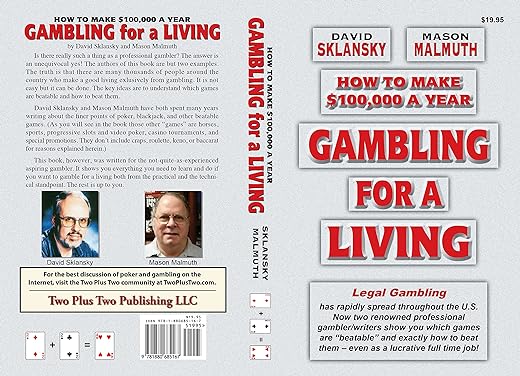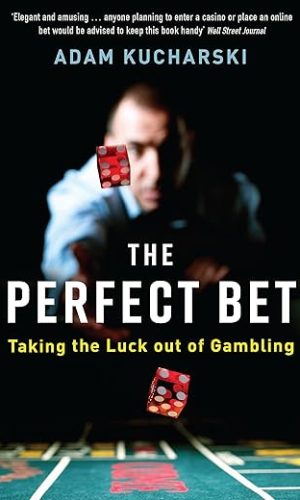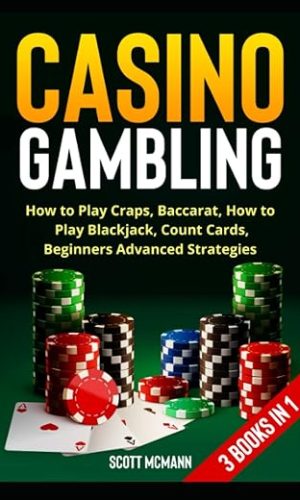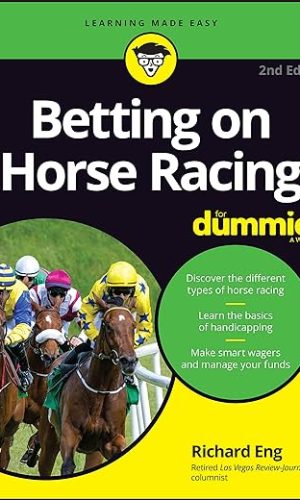Gambling for a Living: How to Make $100,000 a Year
£8.40
Is there really such a thing as a professional gambler? The answer is an unequivocal, “Yes!” This book’s authors are but two examples. Many thousands of people around the country make a good living exclusively from gambling. It is not easy, but it can be done. The key is to understand which games are beatable and know how to beat them. David Sklansky and Mason Malmuth have spent many years writing about the finer points of poker, blackjack, and other beatable games. As you will see in the book, those other “games” are horses, sports, progressive slots and video poker, casino tournaments, and special promotions. They don’t include craps, roulette, keno, or baccarat for reasons they’ll explain. This book, was written for the not quite as experienced aspiring gambler. It shows you everything you need to learn and do if you want to gamble for a living from both the practical and the technical standpoints. The rest is up to you.
Read more
Additional information
| Publisher | Two Plus Two Publishing LLC (4 Oct. 2022) |
|---|---|
| Language | English |
| File size | 7975 KB |
| Text-to-Speech | Enabled |
| Screen Reader | Supported |
| Enhanced typesetting | Enabled |
| X-Ray | Not Enabled |
| Word Wise | Not Enabled |
| Sticky notes | On Kindle Scribe |
| Print length | 360 pages |










by T Mardling
Don’t fall for it,
making 100,000 a year?
the old days have gone,
I was professional gambler,
take my advice, don’t try to do this for a living,
stop dreaming.
I was making money when I was younger and I was a professional gambler,
I still quit and get on with a new life.
becoming a professional gambler is a lonely and depressing journey,
get on with a new life my friend.
by Dennis Littrell
Sklansky and Malmuth do a good job of introducing the reader to the world of gambling for a living. They make it clear just which games can be beaten and which can’t (see below) and which may be beaten depending on circumstances (e.g., progressive slots and video poker). The authors also give a brief sketch of casino games that cannot be beaten (at least by normal means) such as craps, roulette, keno, etc, and point out why they can’t be beaten.
Clearly if you hope to make a living gambling you will become an expert on one (or more) of the four major games that can be beaten. They are horse race betting, sports betting, poker, and blackjack. The authors introduce the games with an emphasis on the circumstance and milieu in which you will find yourself. For example, if you are going to play blackjack for a living you have to get the basic strategy down pat, learn to count cards unnoticeably, and even learn to dress and behave appropriately so that it takes a long time for the pit bosses to realize that you are a winning player and throw you out.
If poker is your choice then you’ll have to learn the game(s) through experience (with some help from the literature). You’ll start at the small games and work your way up, all the while making sure you have a sufficient bankroll separate from your living expenses. Sklansky and Malmuth make a big deal about this, but I can tell you from personal experience more would-be professionals failed because they couldn’t or wouldn’t play within their bankroll than for any other reason. It’s called “gambler’s ruin.” Many of the guys I knew who managed to stay in the game year after year had a working wife or rich parents or some other means to fall back on after they went bust. The authors recommend from 200 to 300 times the big bet in your game as a minimum stake against a bad run of cards. This will vary depending on your variance, your style, how many hands you play, and against whom. Of course if you play too many hands you become a loser no matter how skilled you are. Play against the best players in the world and you also find yourself “on the rail,” which is why Sklansky and Malmuth also recommend that you spend some serious time selecting the games to play in, that is, find the easiest games available at your bankroll and skill level.
The section on sports betting is encouraging, as the authors show how the bookie’s line can be beaten, but what the authors fail to say is that these opportunities (a line out of line, so to speak) come up much less often than bettors would like; in fact so seldom that unless you are betting tens of thousand of dollars on the games, it is very difficult to make a living betting on sports. Furthermore, behind the sly insights one might have into the psychology of a particular game situation–as opposed to an analysis of the comparative strengths of the teams (“power ratings”)–is the assumption that (1) such factors are not already in the line; and (2) the sports bettor knows them better than the line makers.
The only reliable way to beat sports beating in my opinion is to have intimate knowledge of the teams and to shop the line, that is live and breathe the teams like a fan (only with objectivity) and pick the best price given by several books. A professional line shopper I knew had a team of people who would bet for him in various cities across the country. Clearly in L.A. most bettors want to bet on the Dodgers so LA bookies overprice the boys in blue. But just the opposite is the case in Atlanta where the bookies overprice the Braves. Solution, bet on the Dodgers in Atlanta and on the Braves in LA!
The main problem with this book, despite all the absolutely accurate assessment of the games, is, it’s out of date. Written over ten years ago, it does not give the reader any information on Internet play and there is little that reflects the enormous increase in the tournament action both online and in the casinos. Furthermore, although Sklansky and Malmuth warn the reader gently that there’s a lot of work to be done to get to the professional level, and again warn the reader that there are pitfalls along the way, they fail to convey–at least to my mind–just how hard it is be a successful gambler. Most people cannot do it. Furthermore, most people, if they could do it, would not because, frankly, it’s a lot of work and can get boring. Playing poker or betting on sports can be a lot of fun if it’s done just for fun and recreation, but if you have to grind it out, it can get tedious and you’ll miss the sunshine and the greenery. One of the sad sights that I used to see in the clubs was a middle level professional running rough and absolutely hating to be there. You could almost hold your breath until he went completely on tilt.
And that’s why the rounder’s dictum is that gambling is “a hard way to make an easy living.” I don’t think Sklansky and Malmuth are completely candid about the obstacles, both technical and psychological that challenge the prospective professional. They set out the cautions in a clear manner (the book is eminently readable), but they do not actually convey just how difficult it is to achieve the stated goal of making $100,000 a year gambling, mainly because for them–level-headed mathematicians fascinated by probability–it was not nearly as difficult as it would be for many others. I might also point out that Sklansky has now made more money writing books than he ever made playing cards.